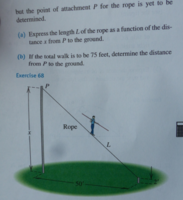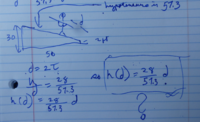allegansveritatem
Full Member
- Joined
- Jan 10, 2018
- Messages
- 962
Here is the problem:

Here is exercise 68 that is alluded to above--in the book it is divided by a page break so I am going to type the first part (in order not to stuff too many images into one post) and then I will upload the second part that contains the diagram):
Length of a Tightrope: The figure illustrates the apparatus for a tightrope walker.Two poles are set 50ft apart,

Here is my solution to this:

This is the only way I could see to work this out. It surprised me that it was so easy....which puts me on my guard. Is the the way to go with this problem?

Here is exercise 68 that is alluded to above--in the book it is divided by a page break so I am going to type the first part (in order not to stuff too many images into one post) and then I will upload the second part that contains the diagram):
Length of a Tightrope: The figure illustrates the apparatus for a tightrope walker.Two poles are set 50ft apart,

Here is my solution to this:

This is the only way I could see to work this out. It surprised me that it was so easy....which puts me on my guard. Is the the way to go with this problem?
